Last Updated on: 25th August 2025, 03:14 pm
Dribbling Drills
Beginner Drills For Dribbling
Dribbling is the art of maintaining possession of the ball as you move it past your opponent. It’s an essential skill that will elevate a player’s performance, so you’ll want to introduce plenty of dribbling drills and games into your training sessions. There are plenty of options but we’ve selected a few to get you started.
Why is dribbling important?
Dribbling is one of those skills that separates great players from average ones. To get ahead in the game, it’s vital that they can get the ball past a defender. Being good at dribbling allows them to:
- Maintain possession: Players can dribble to space to keep possession of the ball.
- Beat defenders: A player who can skilfully dribble can break through defences and create scoring opportunities.
- Relieve pressure: Dribbling can create time and space to relieve pressure on the pitch.
For beginners, running through dribbling drills builds confidence and improves their foot-eye coordination. They’ll be a more versatile and unpredictable player if you can effectively dribble in different situations.
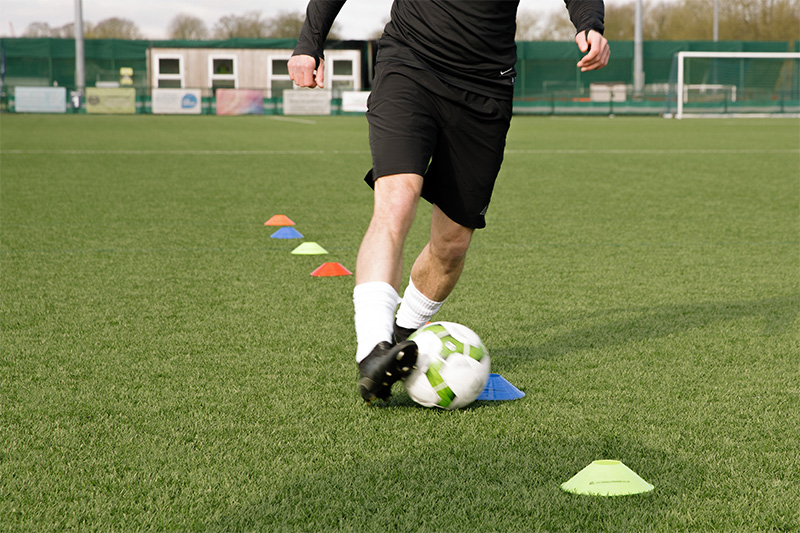
Essential Skills
Dribbling requires a combination of physical and mental skills. Physically, you need to be able to control the ball’s movement. Mentally, you need to know how and when to move. There are several important skills that every player needs to be good at dribbling. You’ll want to ensure they have:
- Strong footwork
- Good balance
- Command of the ball
- Ability to quickly change direction
- Proper touch
- Having the confidence to move with the ball
- Awareness of their opponents
- Quick decision-making and reactions
Tips To Improve Dribbling
Repetition is the best way to approach football training, so plenty of practice will help your players improve. Dedicate time to different dribbling drills that focus on control, balance, and decision-making. Dribbling will become second nature once they get more comfortable with the ball.
- Stay Balanced – Good balance is key to maintaining control. Keeping a low stance lets them shift their weight easily.
- Keep the ball close to your feet – Control the ball with close, soft touches so you can react quickly.
- Always keep your head up – Players must be aware of what’s happening around them. They shouldn’t be focused on the ball.
- Both feet should be strong – This makes them more versatile and less predictable on the pitch.
- Use different parts of the foot – Using various parts of the foot gives players more options and helps keep control in different situations.
- Shield the ball – Keep their body between the ball and the defender to make it harder for them to gain control.
- Change speed – Accelerating or decelerating at the right time will create space and help players break away from defenders.
- Fake out your opponents – Part of dribbling is deceiving your opponent, so use feints and change direction to get away.
Keeping all of these things in mind will leave your players in a good position on the pitch.
Football Dribbling Drills For Beginners
Following the Leader
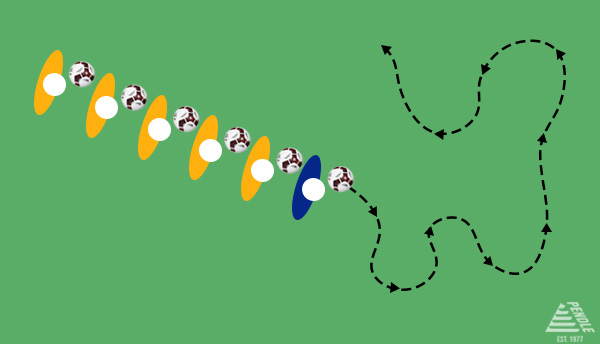
Equipment: 1 football for each player
Set-Up: One player acts as the leader and everyone else lines up behind them.
Instructions:
- The leader starts dribbling and the remaining players must copy their movements.
- The leader should continually change speed, direction and dribbling techniques.
- Followers must pay attention to what the leader does and maintain control of their ball.
- After a few minutes, swap the leader for a new player. Let each player have a chance to lead.
Coaching Points:
- Highlight the importance of keeping the ball close for better control.
- Followers should keep their heads up to observe the leader.
- Get the leader to use different parts of their feet and include turns.
- Followers should be alert to sudden changes in speed and direction.
Progression:
- Increase the tempo of the drill so players have to get faster to help with quick reactions.
- Add in obstacles for players to dribble around. They’ll need to be aware of the ball, the leader and what’s on the pitch.
- The leader should use a variety of dribbling techniques.
Gates Dribbling Drill
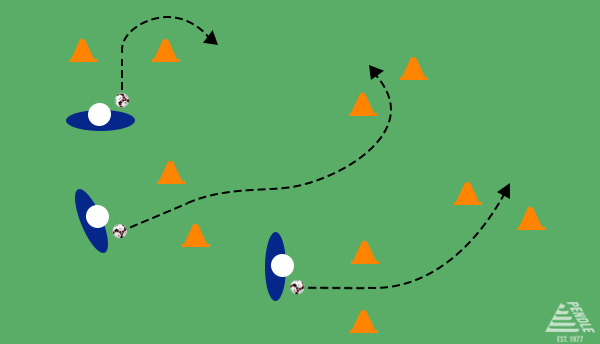
Equipment: Cones, footballs
Set-Up: Use two cones to create “gates” at various points on the field. Keep about 1m between each gate.
Instructions:
- Give each player a ball and have them stand apart from each other.
- Get players to dribble through as many gates as possible in 60 seconds.
- Aim to go through different gates each time while maintaining control of the ball.
Coaching Points:
- Focus on fast dribbling, changing direction and spatial awareness to simulate game scenarios.
- Players should know what’s happening around them to avoid other players.
- Helps with reaction time and maintaining control when moving through open spaces.
Progression:
- Reduce the size of the gates, so your players need to be more accurate.
- Add a defender to block the gates or chase the ball to increase pressure.
- Use a smaller ball to refine touch and control.
Musical Cones
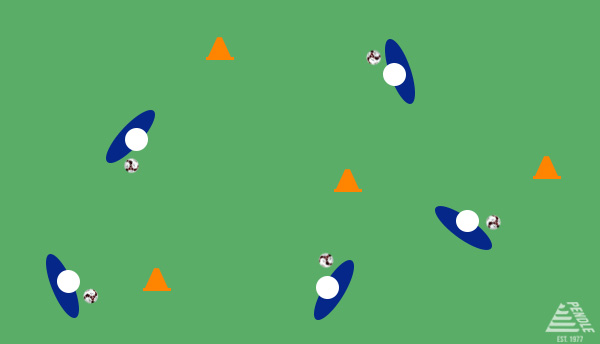
Equipment: Cones, 1 football per player, music/whistle.
Set-Up: Create a grid and set up cones at random points throughout. There should be 1 less cone than the number of players (e.g. 9 players = 8 cones.) Leave plenty of room between each one.
Instructions:
- Blow your whistle/start the music to begin.
- Players must start dribbling their ball around the grid.
- Blow your whistle again/stop the music.
- Players must quickly dribble the ball so they are standing next to a cone. Only one player is allowed at each cone.
- The one player not next to a cone is out of the game and can be given an alternative drill to perform outside the grid.
- Take one cone away before repeating the drill.
- Reduce the number of cones until one player remains standing by a cone. They’re the winner.
Coaching Points:
- Make sure that players continue moving and make use of the whole space. Anyone not moving is warned or disqualified.
- This drill needs a good reaction time. Players need to be quick to react once you blow your whistle.
- Players must be aware of what’s happening around them and pay attention to the whistle/music.
- The drill helps replicate the pressure that players might feel in a match.
Progression:
- Get the players to use their weaker foot during the drill.
- Get the players to focus on different dribbling techniques during the drill. You can shout out commands for them to follow.
- Start with fewer cones so there is more competition per cone.
- Introduce defenders to prevent players from reaching the cones. If a defender takes possession of the ball, they can swap with that player.
Freeze Tag
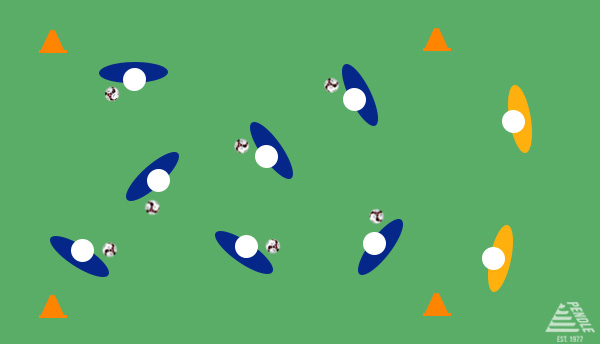
Equipment: Cones, bibs, 1 football per player.
Set-Up: Use the cones to set out an appropriately sized square for the number of players you have. Give 1 or 2 players a bib to mark them as taggers. The remaining players get a football. The taggers start outside the box and the others start inside.
Instructions:
- When the game begins, the players in the square dribble the ball around the grid.
- The taggers enter the square and attempt to tag as many players.
- Once tagged, a player must freeze in place and hold the ball above their head.
- Other players can unfreeze them by dribbling the ball between their feet.
- The game continues for a specific amount of time or until all the players have been frozen.
- If all players are frozen, the taggers win. If the time ends, the players win.
- Switch out the taggers and start again
Coaching Points:
- Focus on quick turning and maintaining possession of the ball under pressure.
- Players with the ball should fake changes of direction to get away from the taggers.
- They must keep their heads up to focus on what’s around them and notice when another player is frozen.
Progression:
- Add in additional taggers.
- Place obstacles that players need to avoid.
- Once a player has been tagged a few times, they can be turned into a tagger.
Shadow Dribbling
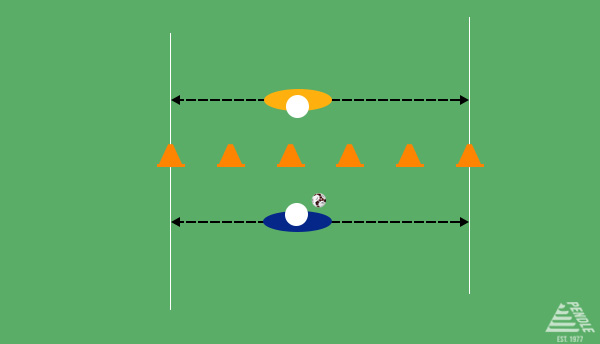
Equipment: Cones and 1 football per pair.
Set-Up: Divide the team into evenly matched pairs. Set up a line of cones and have the two players stand opposite each other on either side of the line. They cannot cross over. Make one player the attacker and give them the ball.
Instructions:
- The attacker dribbles the ball in various directions to lose the defender.
- The defender must react and remain opposite the attacker.
- When the attacker successfully reaches one of the cones before the defender, they win.
- Get the players to switch roles.
Coaching Points:
- Players should try to drag the ball sideways with the inside of the foot.
- They should lift the foot over the ball when faking moves and when changing direction with the outside of the foot.
- Attackers should use vigorous and convincing body movements to fake changes of direction.
Progression:
- Give the attacker a time limit to reach one of the cones.
- Have the attacker stand with their back to the defender. This will encourage them to screen the ball.
Training Equipment
Fun dribbling drills and games are a great way for younger players to develop their footballing skills. It not only helps them get the technical side right but it increases their enjoyment of the game. Setting up these football dribbling drills is easy with our range of training equipment. Grab everything you need in one place. We’ve got cones, markers, poles and footballs plus kit bags, water bottles and bibs.
Resources:
- Alan Hargreaves and Richard Bate, (2010) Skills and Strategies For Coaching Soccer, 2nd Edition, Human Kinetics

